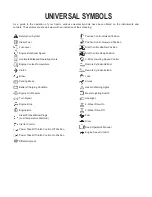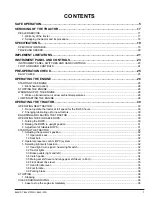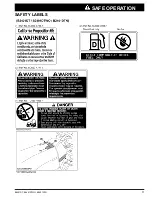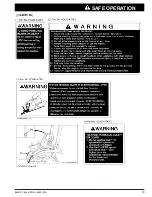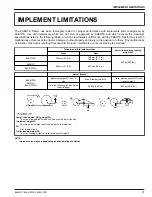
• If the tractor is equipped with a foldable ROPS it
may be temporarily folded down only when
absolutely necessary for areas with height
constraints. (There is no operator protection
provided by the ROPS in the folded position. For
operator safety the ROPS should be placed in the
upright and locked position and the seat belt
fastened for all other operations.)
• Always use the seat belt if the tractor has a CAB or
ROPS. Do not use the seat belt if a fordable ROPS
is down or there is no ROPS. Check the seat belt
regularly and replace if frayed or damaged.
(1) ROPS
(2) Seat belt
OPERATING THE TRACTOR
Operator safety is a priority. Safe operation, specifically
with
respect
to
overturning
hazards,
entails
understanding the equipment and environmental
conditions at the time of use. Some prohibited uses
which can affect overturning hazards include traveling
and turning with implements and loads carried too high
etc. This manual sets forth some of the obvious risks,
but the list is not, and cannot be, exhaustive. It is the
operator's responsibility to be alert for any equipment or
environmental condition that could compromise safe
operation.
1. Starting to operate the tractor
• Always sit in the operator's seat when starting
engine or operating levers or controls. Adjust seat
per instructions in the operating the tractor section.
Never start engine while standing on the ground.
• Before starting the engine, make sure that all levers
(including auxiliary control levers) are in their
neutral positions, that the parking brake is engaged,
and that both the clutch and the power take-off
(PTO) are disengaged or
“OFF”
.
Fasten the seat belt if the tractor has a CAB or a
foldable ROPS in the upright and locked position.
• Do not start engine by shorting across starter
terminals or bypassing the safety start switch.
Machine may start in gear and move if normal
starting circuitry is bypassed.
• Do not operate or idle engine in a non-ventilated
area. Carbon monoxide gas is colorless, odorless,
and deadly.
• Check before each use that operator presence
controls are functioning correctly. Test safety
systems.
(See Checking engine start system on page 69)
Do not operate unless they are functioning
correctly.
2. Working the tractor
• Pull only from the drawbar. Never hitch to axle
housing or any other point except drawbar; such
arrangements will increase the risk of serious
personal injury or death due to a tractor upset.
(1) Drawbar
• For trailing PTO-driven implements, set the drawbar
to the towing position.
• Attach pulled or towed loads to the drawbar only.
• Keep all shields and guards in place. Replace any
that are missing or damaged.
• Avoid sudden starts. To avoid upsets, slow down
when turning, on uneven ground, and before
stopping.
• The tractor cannot turn with the differential locked
and attempting to do so could be dangerous.
• Do not operate near ditches, holes, embankments,
or other ground surface features which may
collapse under the tractor's weight. The risk of
tractor upset is even higher when the ground is
loose or wet. Tall grass can hide obstacles, walk the
area first to be sure.
• Watch where you are going at all times. Watch for
and avoid obstacles. Be alert at row ends, near
trees, and other obstructions.
• When working in groups, always let the others
know what you are going to do before you do it.
• Never try to get on or off a moving tractor.
• Always sit in the operator's seat when operating
levers or controls.
SAFE OPERATION
6
B2401DT, B2401DTWO, B2401DTN
Содержание B2401DT
Страница 6: ......
Страница 17: ...SAFETY LABELS SAFE OPERATION B2401DT B2401DTWO B2401DTN 11...
Страница 18: ...SAFE OPERATION 12 B2401DT B2401DTWO B2401DTN...
Страница 19: ...SAFE OPERATION B2401DT B2401DTWO B2401DTN 13...
Страница 20: ...SAFE OPERATION 14 B2401DT B2401DTWO B2401DTN...
Страница 21: ...SAFE OPERATION B2401DT B2401DTWO B2401DTN 15...



